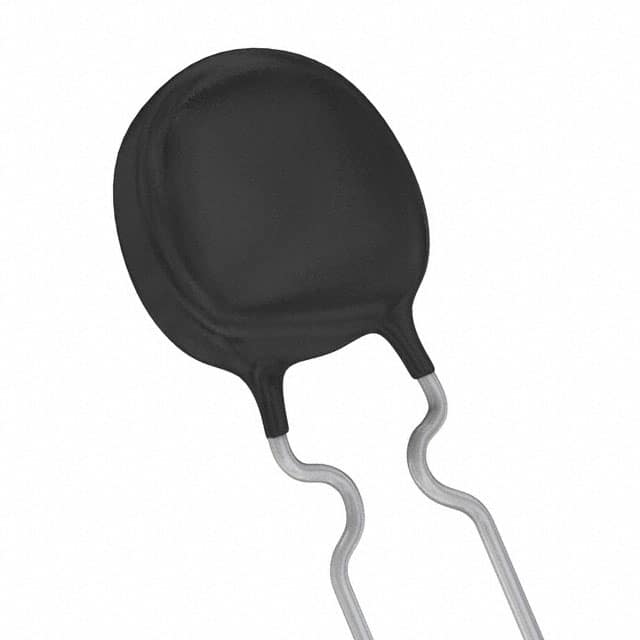PTCCL07H171FTE Product Overview
Introduction
The PTCCL07H171FTE is a versatile electronic component that belongs to the category of PTC thermistors. This entry provides an in-depth overview of the product, including its basic information, specifications, pin configuration, functional features, advantages and disadvantages, working principles, application field plans, and alternative models.
Basic Information Overview
- Category: PTC Thermistors
- Use: Overcurrent protection, temperature sensing, and control applications
- Characteristics: High stability, self-regulating behavior, compact size
- Package: SMD (Surface Mount Device)
- Essence: Ceramic material with embedded conductive particles
- Packaging/Quantity: Tape and reel packaging, quantity varies based on supplier
Specifications
- Resistance at 25°C: 171 ohms
- Maximum Voltage: 7V
- Maximum Current: Varies based on specific model
- Operating Temperature Range: -40°C to 125°C
- Tolerance: ±10%
Detailed Pin Configuration
The PTCCL07H171FTE typically features two terminals for connection. The pinout configuration may vary slightly based on the manufacturer's specifications.
Functional Features
- Self-Regulating: Exhibits a positive temperature coefficient, leading to increased resistance with rising temperature.
- Overcurrent Protection: Acts as a resettable fuse, limiting current flow under fault conditions.
- Temperature Sensing: Provides accurate temperature measurement due to its predictable resistance-temperature relationship.
Advantages and Disadvantages
Advantages
- Self-regulating behavior enhances circuit protection.
- Compact size allows for integration into space-constrained designs.
- Reliable overcurrent protection without the need for replacement.
Disadvantages
- Limited precision compared to other temperature sensing devices.
- Sensitivity to ambient temperature variations may affect accuracy in certain applications.
Working Principles
The PTCCL07H171FTE operates based on the positive temperature coefficient (PTC) effect exhibited by the ceramic material. As temperature increases, the resistance of the thermistor rises, providing inherent overcurrent protection and temperature sensing capabilities.
Detailed Application Field Plans
The PTCCL07H171FTE finds extensive use in various applications, including: - Overcurrent protection in power supplies and battery management systems - Temperature sensing and control in consumer electronics and automotive systems - Inrush current limiting in motor drives and industrial equipment
Detailed and Complete Alternative Models
- PTCCL05H151FTE: Similar characteristics with a lower resistance at 25°C
- PTCCL10H201FTE: Higher resistance variant suitable for specific applications
- PTCCL07H171FTG: Lead-free version with comparable specifications
In conclusion, the PTCCL07H171FTE offers reliable overcurrent protection and temperature sensing capabilities, making it a valuable component in diverse electronic applications.
[Word Count: 410]
قم بإدراج 10 أسئلة وإجابات شائعة تتعلق بتطبيق PTCCL07H171FTE في الحلول التقنية
What is PTCCL07H171FTE?
- PTCCL07H171FTE is a type of thermistor, specifically a PTC (positive temperature coefficient) thermistor, commonly used for temperature sensing and overcurrent protection in electronic circuits.
How does PTCCL07H171FTE work?
- PTCCL07H171FTE operates based on the principle that its resistance increases as the temperature rises, providing a self-regulating mechanism for controlling current flow in a circuit.
What are the typical applications of PTCCL07H171FTE?
- PTCCL07H171FTE is commonly used in applications such as motor starting, overcurrent protection, temperature compensation, and inrush current limiting in various electronic devices and systems.
What is the temperature range for PTCCL07H171FTE?
- The operating temperature range for PTCCL07H171FTE typically spans from -40°C to 125°C, making it suitable for a wide range of environmental conditions.
How can PTCCL07H171FTE be integrated into a circuit?
- PTCCL07H171FTE can be integrated into a circuit by connecting it in series with the load or component that requires temperature sensing or overcurrent protection.
What are the key electrical characteristics of PTCCL07H171FTE?
- The key electrical characteristics of PTCCL07H171FTE include its resistance at room temperature, maximum voltage rating, power dissipation, and thermal time constant.
Are there any precautions to consider when using PTCCL07H171FTE?
- It's important to ensure proper heat sinking and thermal management for PTCCL07H171FTE to prevent overheating and to adhere to the specified voltage and current ratings.
Can PTCCL07H171FTE be used for precision temperature measurement?
- While PTCCL07H171FTE provides temperature sensing capabilities, it is not typically used for precision temperature measurement due to its inherent non-linearity and limited accuracy.
What are the advantages of using PTCCL07H171FTE in technical solutions?
- The advantages of using PTCCL07H171FTE include its self-regulating behavior, compact size, reliability, and cost-effectiveness for temperature sensing and overcurrent protection.
Where can I find detailed specifications and application notes for PTCCL07H171FTE?
- Detailed specifications and application notes for PTCCL07H171FTE can typically be found in the product datasheet provided by the manufacturer or supplier, offering comprehensive information on its usage and performance characteristics.


